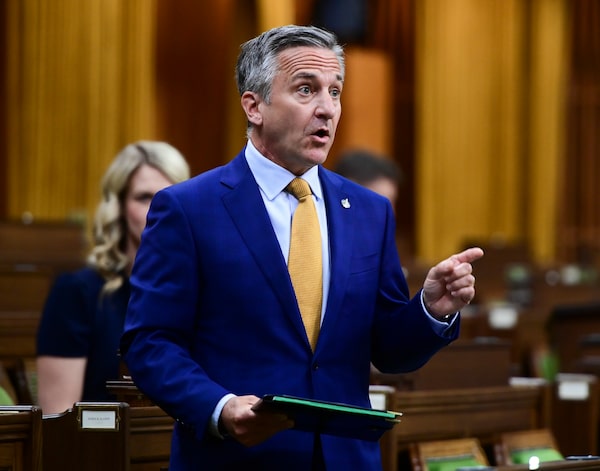
Conservative member of Parliament James Cumming rises during question period in the House of Commons on Parliament Hill in Ottawa on June 3, 2021.Sean Kilpatrick/The Canadian Press
You’d think that with vaccinations rolling out and an election coming, the hottest political issue would be economic recovery. Yet oddly, the Liberal government’s budget and its $101-billion recovery plan didn’t generate a lot of talk. Across the aisle, Conservatives haven’t been too clear on what they’d do differently.
The Liberal blueprint is out there, sort of, in a budget bill before Parliament. But the Conservatives’ recovery plan is still a few bullet points sketched out by Leader Erin O’Toole.
So it’s worth asking. Do the Tories have a different economic recovery policy?
Mr. O’Toole has a bunch of MPs with economic critic’s roles, including one, a relatively unknown, rookie Edmonton MP named James Cumming, whose title is shadow minister for COVID-19 economic recovery.
That’s border reopening and vaccines in the short-term, Mr. Cumming said in an interview, but also what comes after that. There will be a spike in the economy after a pandemic slowdown, Mr. Cumming said, but businesses are already wondering about longer-term growth.
Mr. Cumming’s critique of the Liberal plan suggests a somewhat different approach – an emphasis on longer-term growth; focusing recovery spending on “concrete” assets like port installations but also broadband and tech infrastructure; more emphasis on natural resources; more detail on green-economy plans; and a clearer identification of where new jobs are supposed to come from.
That isn’t a full plan. It’s a good bet Mr. O’Toole’s team won’t unveil their fiscal plan until an election campaign. Mr. Cumming won’t say if the Tories would spend on a similar scale as the Liberals’ $101-bilion. But he argued that what Canada needs is a growth plan. Let’s see if the Conservatives come up with one that looks beyond the election.
Finance Minister Chrystia Freeland sold her budget as a growth plan, although figures such as former Bank of Canada governor David Dodge note the consumption spending outweighs the growth measures. It was heavily focused on re-election, not enough on what comes after.
Mr. Cumming, whose career before politics included working in the private sector and heading Edmonton’s Chamber of Commerce, said the Conservatives would prefer to do more structural change, like deregulation and tax changes, so there needs to be less spending.
But he also argued that federal spending in a recovery plan has to be focused on “concrete” assets that generate growth, increase competitiveness and promote exports and trade. The Liberals’ $101-billion plan lacks specifics and focus, he said.
“My fear is that much of what they will do will be spending in areas that won’t necessarily provide that economic growth that we want. And actually it could have the net negative of really driving inflation in certain sectors.”
Any big spending plan can drive up inflation – at 3.6 per cent, already above the Bank of Canada’s target range – but Mr. Cumming said that if the government takes that risk, it should come away with a growth-promoting tangible asset, like ports infrastructure or roads, or technological assets such as better broadband networks. The latter, he said, can promote remote work that can help regional development.
“We’re a big honkin’ country and it’s an essential service we’re going to need to have,” he said.
One of his biggest criticisms of the Liberal plan is that it isn’t specific enough about where the growth, and jobs, are supposed to come from.
The Conservatives haven’t done that, either, although Mr. Cumming said he’d point to the potential for growth in agricultural exports. He said the government of Canada could promote Canada’s tech sector through procurement, buying its newly developed products rather than giving it grants.
One criticism the Conservatives have made clear is that they think the Liberals aren’t promoting natural resources. Mr. Cumming said Canada should promote the export of liquefied natural gas as a replacement for coal, but also that the government should treat “traditional sectors,” like mining and agriculture, as Canada’s strategic strengths.
Should it promote the green economy? Yes, but with more precision, Mr. Cumming argued.
The government has announced big programs, including an $8-billion “Net Zero Accelerator,” with vague details, and hasn’t explained its promised transition plans for oil workers. “Where are these new jobs? What mechanism?”
Do those critiques make a recovery plan? No. The Conservatives are still woefully short on details of their own. Let’s hope they come up with some that spark a debate about the economy that looks beyond election day.
Know what is happening in the halls of power with the day’s top political headlines and commentary as selected by Globe editors (subscribers only). Sign up today.
 Campbell Clark
Campbell Clark